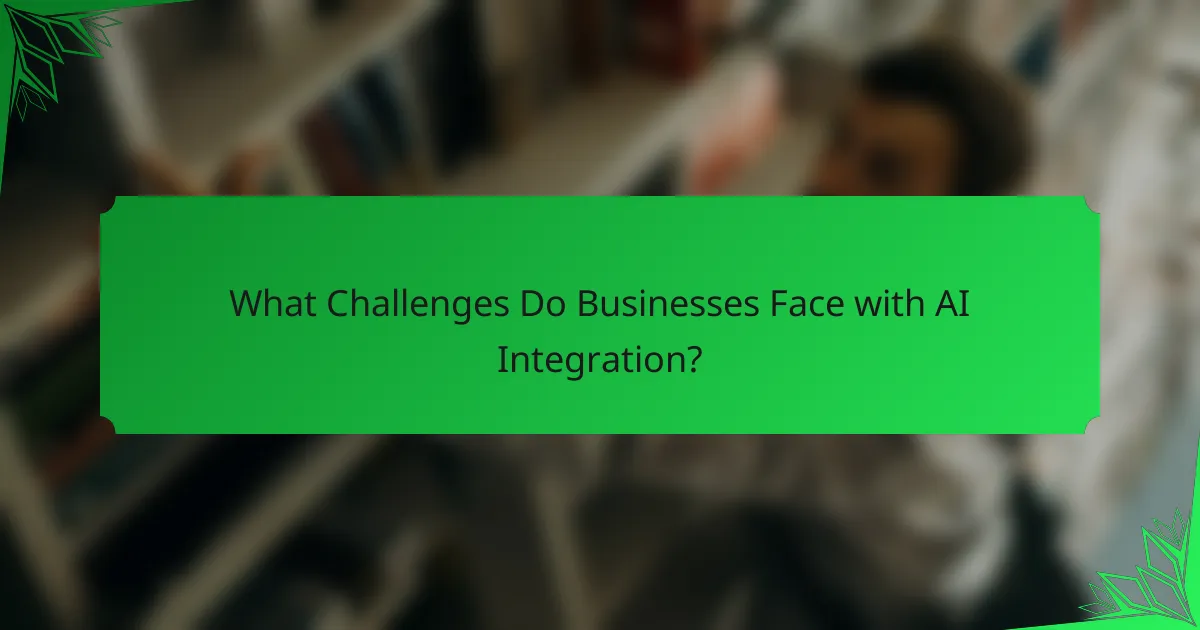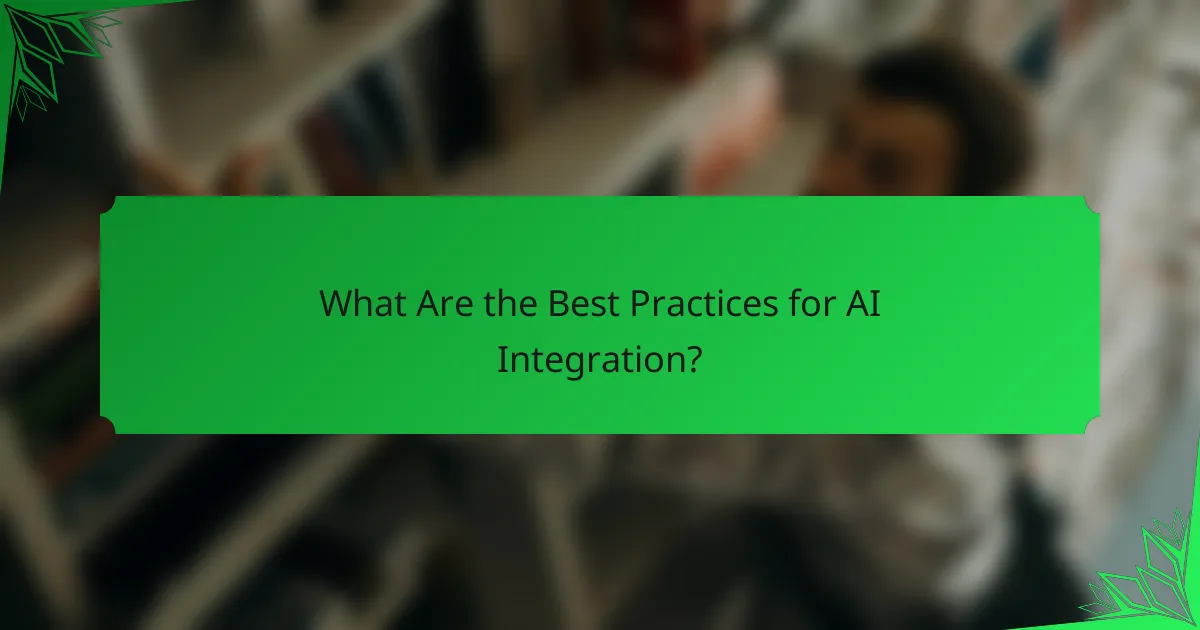AI integration presents a transformative opportunity for businesses, offering benefits such as enhanced efficiency, improved decision-making, and superior customer experiences. However, organizations must navigate challenges like data privacy, implementation costs, and skill shortages to fully leverage these advantages. Strategic planning and effective training are essential for overcoming these hurdles and ensuring successful AI adoption.

What Are the Key Benefits of AI Integration?
AI integration offers significant advantages, including improved efficiency, better decision-making, and enhanced customer experiences. These benefits can transform operations across various sectors, making businesses more competitive and responsive to market demands.
Increased efficiency
AI integration can streamline processes, reducing the time and effort required to complete tasks. For instance, automating routine data entry can free up employees to focus on more strategic activities, leading to productivity gains.
By implementing AI-driven tools, organizations can achieve faster turnaround times and minimize human error. This efficiency often translates to higher output and better resource allocation.
Enhanced decision-making
AI systems analyze vast amounts of data quickly, providing insights that support informed decision-making. By leveraging predictive analytics, businesses can anticipate trends and make proactive choices rather than reactive ones.
For example, retailers can use AI to analyze customer purchasing patterns, allowing them to optimize inventory levels and tailor marketing strategies effectively. This data-driven approach enhances strategic planning and operational agility.
Cost reduction
Integrating AI can lead to substantial cost savings by automating labor-intensive tasks and optimizing resource use. Companies often find that AI reduces operational costs by minimizing waste and improving efficiency.
Additionally, AI can help identify areas for cost-cutting, such as reducing energy consumption in manufacturing processes. These savings can significantly impact the bottom line, especially for small to medium-sized enterprises.
Improved customer experience
AI enhances customer interactions by providing personalized experiences and efficient service. Chatbots and virtual assistants can handle inquiries 24/7, ensuring customers receive timely responses.
Moreover, AI can analyze customer feedback and behavior to tailor products and services to meet specific needs. This level of personalization fosters customer loyalty and satisfaction, which is crucial in competitive markets.
Scalability of operations
AI integration allows businesses to scale operations more effectively without a proportional increase in costs. As demand fluctuates, AI systems can adjust resources dynamically, ensuring optimal performance during peak times.
For instance, cloud-based AI solutions enable companies to expand their capabilities quickly, accommodating growth without significant upfront investment. This flexibility is particularly beneficial for startups and growing enterprises looking to adapt to market changes swiftly.

What Challenges Do Businesses Face with AI Integration?
Businesses encounter several significant challenges when integrating AI technologies, including data privacy concerns, high implementation costs, a lack of skilled personnel, and difficulties in integrating with existing systems. Addressing these issues is crucial for successful AI adoption and maximizing its benefits.
Data privacy concerns
Data privacy is a major challenge for businesses implementing AI, as these technologies often require access to sensitive information. Companies must navigate regulations such as the General Data Protection Regulation (GDPR) in Europe or the California Consumer Privacy Act (CCPA) in the U.S., ensuring compliance while leveraging data for AI insights.
To mitigate privacy risks, businesses should adopt strong data governance policies, anonymize data where possible, and implement robust security measures. Regular audits and employee training on data handling can further enhance privacy protection.
High implementation costs
The costs associated with AI integration can be substantial, encompassing software, hardware, and ongoing maintenance expenses. Initial investments may range from thousands to millions of dollars, depending on the complexity and scale of the AI solution.
To manage costs effectively, businesses should start with pilot projects that require lower investment and can demonstrate quick returns. Gradually scaling successful initiatives can help spread out expenses and reduce financial risk.
Lack of skilled personnel
A significant barrier to AI integration is the shortage of skilled personnel capable of developing and managing AI systems. Many organizations struggle to find data scientists, machine learning engineers, and AI specialists, which can delay projects and increase reliance on external consultants.
To address this skills gap, businesses can invest in training programs for existing employees and collaborate with educational institutions to create a pipeline of talent. Offering competitive salaries and benefits can also attract skilled professionals to the organization.
Integration with existing systems
Integrating AI solutions with existing systems can be complex and time-consuming. Many businesses face compatibility issues, legacy systems that are difficult to update, and the need for significant process reengineering.
To facilitate smoother integration, companies should conduct thorough assessments of their current infrastructure and identify potential bottlenecks. Developing a clear integration strategy that includes phased implementation and stakeholder involvement can help ensure a successful transition.

How to Overcome AI Integration Challenges?
To overcome AI integration challenges, organizations should focus on strategic planning, effective training, and robust data governance. Addressing these areas can significantly enhance the successful deployment of AI technologies.
Invest in training
Investing in training is crucial for ensuring that employees are equipped to work with AI tools effectively. This involves not only technical training for IT staff but also educating end-users on how to leverage AI in their daily tasks.
Consider offering workshops, online courses, and hands-on sessions to facilitate learning. Regularly updating training programs to reflect the latest AI advancements can help maintain a skilled workforce.
Choose scalable solutions
Selecting scalable AI solutions is essential for accommodating future growth and changing business needs. Scalable systems can handle increasing data volumes and user demands without significant overhauls.
Look for cloud-based AI platforms that offer flexibility and can easily integrate with existing systems. This approach minimizes disruptions and allows for smoother transitions as your organization evolves.
Implement robust data governance
Robust data governance is vital for managing the quality, security, and compliance of data used in AI applications. Establish clear policies and procedures to ensure data integrity and protect sensitive information.
Regular audits and compliance checks can help identify potential risks and ensure adherence to regulations such as GDPR or CCPA. Engaging stakeholders across departments can foster a culture of accountability and transparency in data management.

What Are the Best Practices for AI Integration?
To effectively integrate AI into an organization, it is crucial to follow best practices that ensure clarity, efficiency, and alignment with business goals. These practices help in maximizing the benefits of AI while minimizing potential challenges.
Define clear objectives
Establishing clear objectives is essential for successful AI integration. Organizations should identify specific problems that AI can solve or processes it can enhance, ensuring that these goals align with overall business strategies.
For example, a retail company might aim to improve inventory management through AI-driven demand forecasting. By setting measurable targets, such as reducing stockouts by a certain percentage, teams can better assess the effectiveness of their AI initiatives.
Start with pilot projects
Launching pilot projects allows organizations to test AI solutions on a smaller scale before full implementation. This approach helps in identifying potential issues and refining the technology based on real-world feedback.
Consider starting with a project that addresses a specific, manageable task, such as automating customer service responses. This can provide valuable insights and demonstrate the technology’s impact without overwhelming resources.
Ensure stakeholder buy-in
Gaining buy-in from stakeholders is critical for the success of AI integration. Engaging key personnel early in the process fosters collaboration and helps in addressing concerns related to change management.
Communicate the benefits of AI clearly, using data and case studies to illustrate potential improvements. Regular updates and inclusive discussions can further enhance support and commitment across the organization.

How Is AI Integration Transforming Digital Products?
AI integration is fundamentally changing digital products by enhancing functionality and user engagement. It enables personalized experiences, automates mundane tasks, and provides real-time insights, making products more efficient and user-friendly.
Personalization of user experiences
AI integration allows digital products to tailor experiences to individual users by analyzing their behaviors and preferences. For instance, e-commerce platforms can recommend products based on past purchases and browsing history, increasing conversion rates significantly.
To effectively implement personalization, businesses should collect relevant user data while ensuring compliance with privacy regulations like GDPR. A/B testing can also help refine personalized features by comparing user engagement across different approaches.
Automation of routine tasks
By integrating AI, digital products can automate repetitive tasks, freeing up time for users to focus on more complex activities. For example, chatbots can handle customer inquiries, reducing the workload on support teams and improving response times.
When automating tasks, it’s crucial to identify which processes can benefit most from AI. Common pitfalls include over-automation, which can lead to a lack of human touch, and insufficient training data, which may result in inaccurate outputs.
Real-time analytics and insights
AI integration enables digital products to provide real-time analytics, allowing businesses to make informed decisions quickly. For example, marketing platforms can analyze campaign performance as it unfolds, enabling immediate adjustments to optimize results.
To leverage real-time insights effectively, organizations should focus on integrating robust data analytics tools that can process large volumes of data. Regularly reviewing these insights can help identify trends and inform strategic planning, ensuring that the product remains competitive in the market.

What Are the Future Trends in AI Integration?
Future trends in AI integration focus on enhancing automation, improving decision-making, and fostering collaboration between humans and machines. As AI technologies evolve, organizations will increasingly adopt these tools to streamline operations and drive innovation.
Increased Automation Across Industries
Automation is set to expand significantly across various sectors, including manufacturing, healthcare, and finance. Companies are leveraging AI to automate routine tasks, which can lead to increased efficiency and reduced operational costs. For example, in manufacturing, AI-driven robots can handle assembly line tasks with precision, while in finance, algorithms can process transactions faster than human workers.
Enhanced Data Analytics and Decision-Making
AI integration will enhance data analytics capabilities, allowing organizations to make more informed decisions. By analyzing vast amounts of data quickly, AI can identify trends and insights that may not be apparent to human analysts. This trend is particularly relevant in sectors like retail, where businesses can optimize inventory and personalize marketing strategies based on consumer behavior.
Collaboration Between Humans and AI
The future will see a greater emphasis on collaboration between humans and AI systems. Rather than replacing human workers, AI will serve as a tool that augments their capabilities. For instance, in healthcare, AI can assist doctors by providing diagnostic suggestions based on patient data, allowing for more accurate and timely treatment decisions.
Ethical Considerations and Regulation
As AI integration becomes more prevalent, ethical considerations and regulations will play a crucial role. Organizations will need to address issues such as data privacy, bias in algorithms, and transparency in AI decision-making processes. Compliance with regulations, such as the General Data Protection Regulation (GDPR) in Europe, will be essential to ensure responsible AI use.
Investment in AI Talent and Skills Development
To successfully integrate AI, companies will need to invest in talent and skills development. This includes training existing employees and hiring new talent with expertise in AI technologies. Organizations that prioritize continuous learning and adaptation will be better positioned to leverage AI effectively and stay competitive in their industries.
